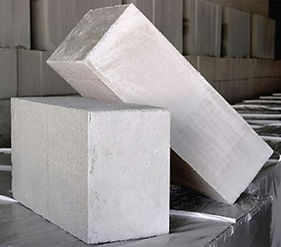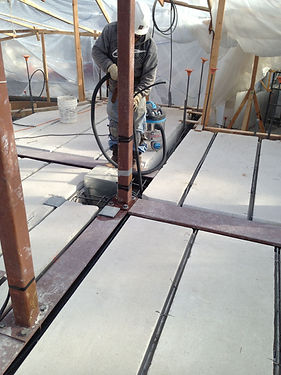




WORLD'S GREENEST BUILDING MATERIAL
Rebuilding Disaster Areas Responsibly

A Game-Changing Material For Residential and Commercial Construction
What is AAC?
c
AAC is a lightweight, eco-friendly, and versatile precast concrete material. Made from a mixture of cement, lime, sand, water, and aluminum powder, it undergoes a high-pressure autoclaving process to create a durable, porous structure that is strong yet lightweight.
Discovery Channel


Introduction To AAC
Autoclaved Aerated Concrete more commonly referred to as AAC, is a closed cell masonry product that comes in blocks or panels. This “aerated” product was first developed in Germany in the 1880s then perfected and patented in the 1920s by a Swedish architect named Johan Axel Eriksson. Sweden and much of Europe were experiencing lumber shortages because of World War I, so an alternative construction method needed to be developed. Dr. Eriksson discovered that by curing the material with heat and pressure in an autoclave, the final product was much stronger and dimensionally accurate than the product when it was “air cured”

Applications
-
Residential: Energy-efficient homes, apartment complexes.
-
Commercial: Offices, retail centers, and warehouses.
-
Public Infrastructure: Schools, hospitals, and government buildings.
Thermal Benefits
-
AAC provides unparalleled energy efficiency:
-
High R-Values: Superior thermal insulation minimizes heating and cooling needs.
-
Energy Savings: Reduces energy consumption by up to 40% compared to traditional materials.
-
Sustainable Design: Keeps homes cooler in summer and warmer in winter, reducing dependency on HVAC systems.
Resilience in Harsh Climates
-
Cold Weather: Retains heat, preventing thermal loss in freezing temperatures.
-
Hot Weather: Reflects heat, reducing cooling loads in tropical or arid climates.
-
Moisture Resistance: Its porous structure prevents water absorption, protecting against mold and mildew.
AAC is a trusted material across the world:
-
Europe: Leading producers like Germany and Sweden use AAC for over 40% of new constructions.
-
Asia: India and China implement AAC to meet rapid urbanization demands.
-
North America: Gaining momentum in the US and Canada due to its energy-saving potential.
-
Middle East & Australia: Used in harsh climates for its durability and thermal benefits.


Global Autoclave Aerated Concrete Market Size is poised to experience significant growth in the forecast timeframe owing to rapid development in infrastructure and construction industry.
-
Current Global Market for AAC is $17.1 Billion
-
Expected Growth $26.9 Billion by 2027
-
Largest growth potential is the lower 48 states of the U.S. due to such a low usage, now along with Federal, State and Local environmental policy changes.
Global Adoption of AAC
AAC Worldwide Usage
• Poland 80%
• Germany 65%
• Australia 60%
• China 50%
• England 50%
• United States .01%

North America
United States
Canada
Mexico

South America
Brazil
Argentina
Colombia

Europe
Germany
United Kingdom
France
Italy
Spain

Asia-Pacific
China
Japan
India
Australia
South Korea

Middle East & Africa
Saudi Arabia
UAE
South Africa
Iraq

Product Type
Block
Wall Panel
Roof Panel
Cladding Panel
Floor Elements
Lintel
Others

End User
Residential
Commercial
Industrial
Infrastructure

By Application
Construction Materials
Roof Insulation
Bridge Sub-Structure
Road Construction
Void Filling

AAC Wall R=15.75

CMU Wall R=15.02

Wood Stud Wall R-15.75

The Advantage of AAC

Weight: Very Light
Workability: Excellent
Wall Installation: Very Fast
Cooling Costs: Very Low
Thermal Rating: Excellent
Indoor Air Quality: Excellent
Seismic Resistance: Excellent
Efflorescence: None
Weight: Much Heavier
Workability: Poor
Wall Installation: Very Slow
Cooling Costs: Very Poor
Thermal Rating: Very Poor
Indoor Air Quality: Poor
Seismic Resistance: Fair
Efflorescence: None
Weight: Very Light
Workability: Very Poor
Wall Installation: Very Slow
Cooling Costs: Very Poor
Thermal Rating: Very Poor
Indoor Air Quality: Very Poor
Seismic Resistance: Poor
Efflorescence: High
Leadership in Energy and Environmental Design known as “LEED,” is an internationally recognized green building certification system. Developed by the United States Green Building Council (USGBC), LEED provides building owners and operators with a framework for identifying and implementing practical and measurable green building design, construction, operations, and maintenance solutions. LEED promotes sustainable building and development practices through a rating system based on points that recognize projects implementing better environmental and health performance strategies.

AAC LEED Certification






More AAC Benefits
-
AAC is non-combustible and inorganic, making it one of the highest hourly fire-resistant building materials in today’s market, with the melting point over 2,912℉.
-
AAC can withstand Tornadoes and Hurricane wind forces exceeding 280 MPH.
-
An Earthquake in 1995 in Kobe, Japan damaged and destroyed over 106,000 buildings, while all 5,578 AAC homes survived.
-
AAC’s inorganic properties leave no nutritional value for molds and fungi to thrive.
-
AAC is the perfect solution against termites, insects, and pest. Its solid construction alleviates voids where pests can live and or colonize.
-
AAC has been proven to drastically reduce the impact of noise pollution, both inside and outside of the building. Its noise reduction coefficient is more than seven times that of ordinary concrete.
-
AAC even when plastered and painted is able to capture carbon dioxide from the environment. CO2 molecules penetrate the structure reacting with water, the Carbonic acid created in such way reacts with calcium within the hydrated calcium silicate structure, in result calcium carbonate is formed. Calcium carbonate strengthens the structure of AAC and the carbon dioxide that was used to create it irretrievably disappears from the climate. AAC not only reduces energy demands but also helps to protect the environment by removing CO2 emissions.
AAC Benefits
-
All of our buildings are made from Autoclaved Aerated Concrete, which is fire, hurricane, earthquake, tornado and flood resistant. As well as being sound resistant and a thermal insulator.
-
Lighter weight than traditional masonry or cement products
-
No off gassing of toxins when exposed to fire
-
Will not support the growth of mold or mildew
-
Termites, other insects or rodents will not eat it
-
100% recyclable material can easily be crushed back into sand
-
Long life, is not affected by harsh climates or extreme weather conditions
AAC Benefits
Fire Resistance

6,000 Degrees Fire Test
Autoclaved aerated concrete provides the highest security against fire and meets the most stringent fire safety requirements.
It is both resistant to fire up to 2900°C and, unlike other construction materials, heat-resistant, thereby protecting lives and economic assets.
Fire wall should last up to four hours but tests have shown that an AAC fire wall just 150 mm thick can resist at least for six hours. In a real blaze, an AAC fire wall even survived intact for 120 hours.
Besides being fire- and heat-resistant, AAC does not give off any smoke or toxic gases, which can endanger human life more than fire itself.

Environment
AAC can not only ensure more efficient use of energy in buildings, but also serves as a CO2 reservoir as it ages by binding CO2 through a process known as carbonization. Researchers are now investigating this property in greater detail and are looking for improved methods to contribute even more to climate protection.
AAC even when plastered and painted is able to capture carbon dioxide from the environment. CO2 molecules penetrate the structure reacting with water, the Carbonic acid created in such way reacts with calcium within the hydrated calcium silicate structure, in result calcium carbonate is formed. Calcium carbonate strengthens the structure of AAC and the carbon dioxide that was used to create it irretrievably disappears from the climate. AAC not only reduces energy demands but also helps to protect the environment by removing CO2 emissions.

